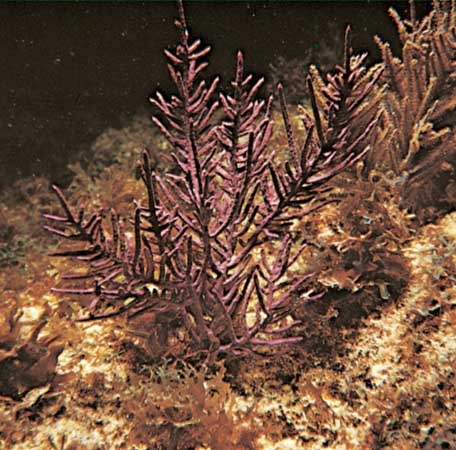sea fan
invertebrate
 (Gorgonia), any of a genus of invertebrate marine animals of the order Gorgonacea (class Anthozoa, phylum Cnidaria). It is a variety of coral composed of numerous polyps—cylindrical sessile (attached) forms—that grow together in a flat, fanlike pattern. Each polyp in the colony has some multiple of six tentacles, as opposed to the eightfold symmetry of the similar black coral. A central internal skeleton, composed of a flexible, horny substance called gorgonin, supports all branches of the colony, and the living tissues form a layer over its entire surface. The tissues are often coloured in hues of red, yellow, or orange. The polyps spread out their tentacles to form a plankton-catching net. In most cases the fan-shaped colonies grow across the current, which increases their ability to ensnare prey.
(Gorgonia), any of a genus of invertebrate marine animals of the order Gorgonacea (class Anthozoa, phylum Cnidaria). It is a variety of coral composed of numerous polyps—cylindrical sessile (attached) forms—that grow together in a flat, fanlike pattern. Each polyp in the colony has some multiple of six tentacles, as opposed to the eightfold symmetry of the similar black coral. A central internal skeleton, composed of a flexible, horny substance called gorgonin, supports all branches of the colony, and the living tissues form a layer over its entire surface. The tissues are often coloured in hues of red, yellow, or orange. The polyps spread out their tentacles to form a plankton-catching net. In most cases the fan-shaped colonies grow across the current, which increases their ability to ensnare prey.In reproduction, fertilized eggs develop into microscopic ciliated larvae (planulae). Each larva disperses from the parent colony before it metamorphoses in adult form. Each newly metamorphosed polyp eventually gives rise to an entire sea fan colony through asexual budding.
There are about 500 species of Gorgonia, and they differ markedly in their branching patterns. All, however, grow to approximately 61 cm (2 feet) in height. Sea fans are found in the shallow waters of all oceans, but they are especially abundant along the Atlantic coasts of Florida, Bermuda, and the West Indies.
- John McGraw
- John McKinley
- John McLaughlin
- John McLean
- John McLeod Campbell
- John M. Cooper
- John McPhee
- John Mellencamp
- John Mercer Langston
- John Michael Hawthorn
- John Michael Rysbrack
- John Michell
- John Middleton, 1st earl of Middleton
- John Middleton Clayton
- John Middleton Middleton, 1st earl of
- John Middleton Murry
- John Millington Synge
- John Milne
- John Milton
- John Milíč
- John Mitchell
- John Mitchell Mason
- John Morgan
- John Morley Morley, Viscount
- John Morley, Viscount Morley